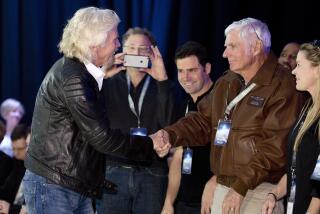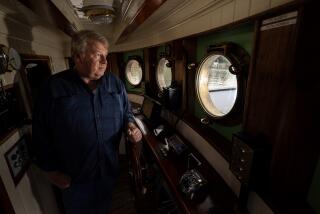Douglas Corrigan; Flew ‘Wrong Way’ Across Atlantic
- Share via
Douglas Corrigan, who became internationally known as “Wrong Way Corrigan” when he headed his single-engine plane west from New York to Long Beach but landed in Ireland, has died. He was 88.
Corrigan, who made his famous “mistake” in 1938, died Saturday in St. Joseph’s Hospital in Orange, his son Douglas told The Times on Tuesday.
The Galveston, Texas-born adventurer moved to Los Angeles in 1922 and became enamored with flying. He worked as an aircraft mechanic and even pulled the chocks on his hero Charles Lindbergh’s “Spirit of St. Louis” on its flight from San Diego to New York before Lindbergh’s pioneering solo flight across the Atlantic on May 21, 1927.
By 1935, Corrigan had learned to fly and paid $310 for a secondhand 1929 Curtiss Robin monoplane that his friends derided as a “crate.” Only 10 pilots had matched Lindbergh’s solo Atlantic crossing by that time, and Corrigan longed to become one of them.
But the Department of Commerce rejected Corrigan’s request for permission to fly the Atlantic because of his plane’s condition, even after he flew the craft nonstop from Long Beach to New York, a greater distance than the Atlantic crossing.
On July 17, 1938, Corrigan loaded 320 gallons of gasoline (enough for 40 hours) into the tiny plane and took off from the East Coast’s Floyd Bennett Field--pointing the nose straight east into a cloud bank, although he had announced that he was heading west to Long Beach.
Corrigan’s instruments included two compasses and a turn-and-bank indicator. The cabin door was literally held shut with baling wire.
Twenty-nine hours later, he landed in Baldonnel near Dublin.
One compass failed to work, Corrigan explained, and the second malfunctioned, pointing 180 degrees in the opposite direction. He forever claimed to be surprised at arriving in Ireland rather than California.
Corrigan had no passport or permit to land and was held in “open detention” by baffled authorities. To prevent him from repeating the “mistake” or stunt, his plane was disassembled and sent back to New York on a ship.
But Corrigan became an international hero. His ticker-tape parade when he sailed into New York was larger than Lindbergh’s. After arriving at Glendale’s Grand Central Air Terminal, he headed a parade through downtown Los Angeles. Schoolchildren got half a day off from school to celebrate.
He was offered film roles by Warner Bros. and Hal Roach, and starred in a 1939 film about himself titled “Flying Irishman.” He received medals and awards, and products including a watch that ran backward were named for him.
A shy, private man, Corrigan became a test pilot for Douglas Aircraft during World War II. He later grew oranges in Santa Ana, where he had lived since 1951.
At the time of his “mistake,” Corrigan remained front-page news in Europe and the United States for months. A writer who was a high school senior when Corrigan flew to Ireland tried to explain why Corrigan remained a sensation in 1990, years after aircraft had circled the world at supersonic speed and spacecraft had landed on the moon.
“What really turned us on,” the admirer wrote, “was the way Corrigan--as had Lindbergh--exemplified a deeply felt American theme: the loner who defies all odds to achieve a goal both dangerous and difficult. And Corrigan multiplied our admiration by doing it in defiance of authority. . . . [We] loved him for it.”
The little plane was stored in boxes in Corrigan’s Santa Ana garage until 1988, when he reassembled it for display at Hawthorne Municipal Airport.
At that time, a new generation of news media questioned Corrigan about the wrong-way flight, which fliers were certain could never happen to an experienced pilot.
“I made a mistake,” the octogenarian insisted again.
An honest mistake?
“I was never really too honest, you know,” said the Irish American Corrigan, who had legally changed his first name because he admired actor Douglas Fairbanks Sr.
So what is your real name then? persisted the press.
“Clyde,” the old man said, and went to check on his plane.
In addition to his son Douglas, of Santa Ana, Corrigan is survived by another son, Harry, of Apex, N.C., and a sister, Evelyn, of Santa Ynez, Calif. His wife died in 1966, and a third son, Roy, died in a plane crash on Catalina Island.
Services are scheduled at 11 a.m. today in Fairhaven Memorial Park, Santa Ana.
More to Read
Sign up for Essential California
The most important California stories and recommendations in your inbox every morning.
You may occasionally receive promotional content from the Los Angeles Times.










